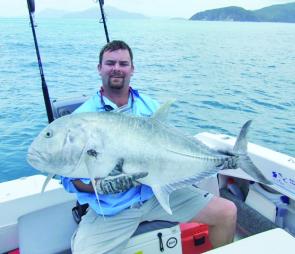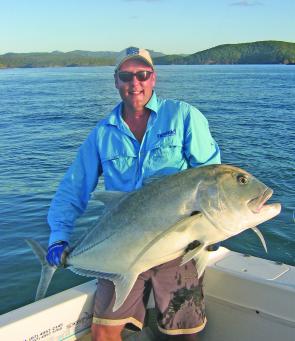Trevally are terrific. They are one of the main stays of Mackay’s fishery during the winter months, but are also available all year round. They can be caught anywhere from the upper reaches of Mangrove Creeks, out to the reef proper.
The different species of trevally all have one thing in common; strength of their performance once hooked.
Trevally at the reef can be a bit of a pest for reef line fisherman at times, taking baits intended for more glamorous species such as coral trout, sweet lip and red emperor. However closer inshore they are always a welcome addition to the catch.
Trevally are not known particularly for their eating qualities, yet are quite good to eat in the smaller sizes. Be sure to take care of the fish after its immediate capture.
The most common trevally caught in this area include golden trevally, GT’s and spotted trevally. These fish can be found throughout the range of environments in the salt water, and are commonly caught in sizes from 1kg up to approximately 20kg.
There is always the chance of running into a huge GT in the offshore regions. Occasionally one of these monsters makes its way up into the mangrove creeks, and smashes up angler’s gear when inadvertently hooked on light line.
Golden trevally are very prevalent throughout Mackay during the winter months and coming into the spring and summer seasons. They are generally taken around the offshore islands, and places such as Flat and Round Top Island, Slade Island, and to the north the islands off Seaforth are all favourite haunts for these fish. Goldens are also often caught out from Sarina Inlet, around Taffy Island and similar spots.
Golden’s are a particularly fine eating fish, provided they are bled immediately on capture. The fillets are large, with little blood colouring, and are easy to prepare for the table. One of my favourite ways of preparing golden trevally is to marinate them for a few minutes in white wine and sweet chilli sauce and garlic, then BBQ. Served with a nice salad it is a meal fit for a king.
One of the other great attributes that attract anglers to trevally is the fact that they will respond to many different types of approach. Trevally will take live baits, strip baits, dead prawns, yabbies and a wide variety of lures and for the fly angler, they also respond to well presented flies. My main interest is in lure and flyfishing, although I have caught plenty of trevally on bait.
One of the most exciting ways to catch trevally is on large poppers, and they will work throughout the mangrove creek systems and out to the offshore islands. Unfortunately, because of safety issues, one of the best areas around Mackay has now been closed off to anglers around the dual coal loading jetties of Hay Point and Dalrymple Bay, just to the South of Mackay.
Many an enjoyable hour has been spent throwing poppers under the jetties and being monstered by sometimes huge trevally. The best fish that I ever saw from here was over 25kg and in that environment, it was a great catch.
One of the most reliable areas to catch trevally around Mackay is near the twin islands of Flat Top and Round Top, out from the mouth of the Pioneer River. This area features deep water, rock ledges, sandbars and some old structure in the form of the remains from the old jetty at Flat Top Island.
The trevally can be found hard up against the rocks and in the deeper water at all times of the year. One of the popular ways of catching trevally in this area is using poppers casting towards the rocks and worked back out. This works well along the eastern side of Flat Top and Round Top Islands, and around the Southern end of Round Top Island. These areas are characterised by rock formations, with shallow water dropping into reasonably deep water.
Shallow diving minnows will also work well here, whilst in the deeper water, the best way to catch trevally is using heavy metal jigs or large plastics mounted on very heavy jig heads.
Most of the water around these islands is less than 15m deep and trevally can be found at any of the small rocky areas just off the main islands. Another way to work is by trolling a mixture of shallow and deep diving lures slowly around the rocky out crops. Using this method covers more ground and the angler is more likely to run across a trevally or two. Quite often several can be caught in the same general area. This is particularly so with the golden trevally which seem to hang about in small schools.
Out off Mackay Harbour and in a general northeasterly direction, is an area known as the Shoals. This area consists of large expanses of sandy bottom with small patches of low rubble rock, strewn throughout.
There are also some old areas where, in the past, trawler cables and the like have been dumped and these hold good populations of trevally. In this environment the best way to locate the trevally is to find bait schools on the depth sounder, and then fish those bait schools with heavy metal jigs or the large plastics previously mentioned.
When jigging, use large jigs as the current run is fairly fierce and the trevally are of a size big enough to hit any metal jig commonly available in the tackle shops.
Raider jigs are universally popular, particularly in the large heavy sizes, and these can be worked through all stages of the water column from the bottom to the surface.
The trick is to locate the bait schools and accompanying larger fish, free spool jigs to the bottom and then work them up to various depths with lots of rod action. The jig should be left to flutter back to the bottom several times during the retrieve, and this is often when trevally will slam the lure and take off with blistering speed. If using an overhead reel for this type of jigging, make sure that you have control of the reel at all times and are able to engage the spool immediately, otherwise a massive overrun will occur.
Some of the long slim type jigs that are now coming onto the market have proved very suitable for this type of fishing. Many local anglers here make their own jigs from lead and dress them up with reflective tape, or dip them in a glue mixture and sprinkle sparkle finish on them. The trevally are not particularly fussy and are attracted more to the movement of the lure than to any particular colour.
The soft plastic scene is only starting to take off here for trevally in deep water, and because of our tidal currents it is necessary to use large heavy jig heads, such as the TT jigs. These can be rigged with large paddle tail bodies, which are available up to about 8” long. These can be worked in exactly the same way as a metal jig. When fish are deep, these jig can actually be kept in the strike zone longer by simply leaving the lure at the desired depth, and allowing the current to work the paddle tail. Unlike the metal jigs the rubber plastic jigs need only the slightest movement to get them working and this can be used to the anglers advantage.
Trevally can sometimes be an absolute nuisance when fishing the Shoals areas for mackerel, cobia and the like, and on those days, it is not unusual to have to keep shifting to avoid the trevally plague. Things are tough around Mackay when you have to leave fish on the chew to go elsewhere.
Many other species can be encountered when chasing trevally, with the more common ones being the various species of mackerel, cobia, tuna and occasionally rather large sharks.
Coming into the spring, September will bring a continuation of the great trevally fishing, and will also see the weather settle down into more east, northeasterly patterns. This will bring the schools of baitfish close inshore followed by mackerel, trevally and other predators.
Spring is a great time to be fishing close offshore around Mackay and is a time for many sickies being taken at work. The best bet is to be on the water early, and get back mid-morning before the winds pick up and make fishing uncomfortable.
On the fresh water scene, spring will see the start up of the barra fishing, both in the dams and in the mangrove creeks. After the cold winter experienced, I expect the weather will warm up very substantially during September. And once the water temperature gets up around 23-24oC, the barra will start to move around much more and become readily available.
Overall spring fishing in the Mackay area is loaded with opportunities – both in the fresh and salt water. See you out there.
Reads: 11863
Trevally are not particularly fussy and are attracted more to the movement of the lure than to any particular colour.

One of the most exciting ways to catch trevally is on large poppers, and they will work throughout the mangrove creek systems and out to the offshore islands.




